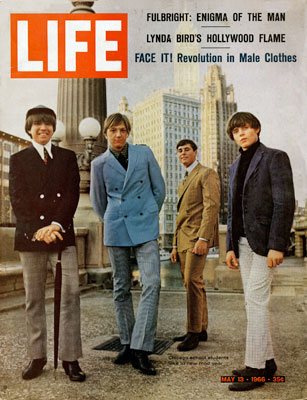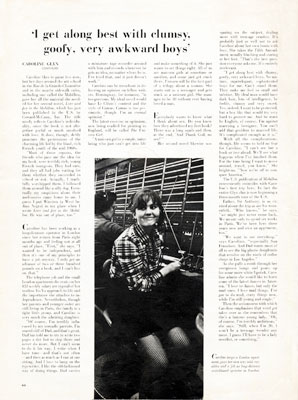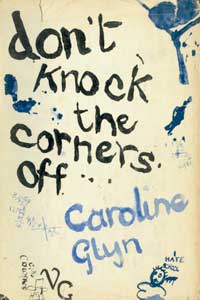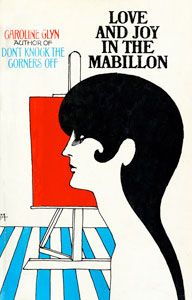
Click image to enlarge
This is a photo taken of me and Caroline Glyn in the summer of 1966, at a bar called the Metropole, at 7th Avenue and 48th Street in New York. It was the first time Caroline had ever been taken to have a cocktail ('don't tell my father, whatever you do!! '), and I was the only boyfriend she ever had who behaved like that. In fact, I think she only ever had one other boyfriend, because she entered a closed convent as a nun. Very few people ever knew Caroline, because she was only available to meet for such a short time. Caroline was a child prodigy as an author, and at the age of 14 published a best-selling novel entitled
Don't Knock the Corners Off. By the age of 21, Caroline had published five novels, showing the trait of prolific authorship which had been the hallmark of her great-grandmother, Elinor Glyn, who also a best-selling novelist, and wrote the much earlier best-seller,
It. Caroline's father was a very strange man (also a novelist) called Sir Anthony Glyn, Bart., but she never allowed me to meet him, because she was convinced he and I would inevitably attempt to kill one another if we ever came face to face. So our relationship was semi-secret. I remember that during this summer, Caroline was written up in
Life Magazine and I still have a copy (below).

Click the image above to see a bigger version of the Life cover and readable article (PDF, 5.2MB) 
This issue of Life Magazine (May 13, 1966) came out while Caroline and I were in New York together. It contained the article about her (see two next pages). Caroline was staying with her parents in Greenwich Village, in the apartment of Susan Sontag, who had rented it to them for a few months. I was staying at the house of my friend Mia Agee, on King Street in Greenwich Village, which was only a few minutes away. |

Click the image above to see a bigger version of the Life cover and readable article (PDF, 5.2MB)


Don't Knock the Corners Off by Caroline Glyn. Please click on the image above to see more information from the book
(PDF, 0.3MB)

Love and Joy in the Mabillon by Caroline Glyn. Please click on the image above to see more information from the book
(PDF, 0.8MB)
To see a press release for the book,
please click here (PDF, 0.5MB)
Caroline and I continued to see each other in England, when she was living alone on her houseboat on the River Cam near Cambridge. We would stay up most of the night discussing the personalities of trees, and other such nature-mystical subjects. It was from Caroline that I first learned of the nature-mystic author Algernon Blackwood. Caroline would walk alone through forests by moonlight all the time, and was frustrated when it was the New Moon, because she couldn't see properly, and actually bumped into trees and tripped on roots. But she was hardy, and did not mind. What was important to her was to be a wood sprite in the dark and all alone. I tried to persuade her to take her with me into the woods, but she always preferred us to be in the pub or on her houseboat where she could see me, as talking in the woods in the dark was not possible, since in the woods at night one has to be silent. Caroline used to get very thrilled at the sound of owls, as my wife Olivia and I still do as well. Caroline loved the books of C. S. Lewis, but I could never get excited by them. Caroline said she was a 'unicorn girl', like her Aunt Elspeth. The concept is explained in Caroline's novel,
The Unicorn Girl. Caroline was a fascinating combination of Jewish and Welsh, which made her glitter like a topaz in the half-light. She lacked social self-confidence and kept thanking me for introducing her to many things which were after all rather ordinary. Knowing her love of forests, I took her to one in New Jersey, where she was speechless with astonishment to discover that all the trees were
different. She had a profound botanical knowledge for Britain, but none for America, and she never got over this shock, which both thrilled and horrified her. She kept talking about it afterwards. Caroline and I were very close, and it was romantic, but there was a barrier beyond which neither of us could pass, due to her problems. She knew that she was psychologically wholly incapable of living in the world. What she did not tell me was that she had a serious congenital heart defect, and it was only after she died in 1981 at the age of 32 in a convent from the exertion of kneeling down and scrubbing a floor that I was informed by her mother that she had been cursed with this problem from birth, and it had excluded the possibility of any normal life for her. I believe she had been told by her doctors when relatively young that marriage and childbirth were out of the question for her, and that survival even into middle age was unlikely.
Caroline was a talented artist as well as a writer. She had studied art in Paris, and wrote a novel about it,
Love and Joy in the Mabillon, where she wrote about herself as a sad, lonely, and ostracised black boy. The Mabillon of the title is the old Cafe Mabillon on the Boulevard St. Germain, which used to be such a charming, cosy and unaffected student hangout. Now, every time I pass it, which I do often, I recoil in horror at the desecration of the place, as it has been converted into one of the most horrible tourist bars imaginable. On her houseboat, I always used to admire Caroline's most ambitious painting, her ten foot-high picture of' John the Baptist Dancing in the Wilderness'. I wish I had one of her pictures, but I don't. She had a horror of curved lines, and did everything with straight lines. Her one exception was the curled goatee beard of a unicorn. Caroline was far more than merely 'unusual', she was unique. I wish there were some way to describe her. She had a terrific sense of humour and sense of fun, and we laughed all the time. Of course she had deep neuroses which defy all analysis, as she well knew. I never challenged her about them. I suppose we were meant to meet and have our deep mutual understanding for that brief time, while her flame flickered so momentarily before she went away to the Other Regions in which she so steadfastly believed. God was as real to her as the dacquiri in the photo, and she absolutely believed in angels and archangels, and often talked about them. She was only half here, and she left so soon to go back to where she belonged. She wrote me a very long letter of farewell when she entered the convent, asking me not to condemn her. I never saw her again. But it would be impossible to forget her. She was such a soft, pale, mischievous, flirty-eyed, and wholly delightful person and companion. I try not to think about Caroline if I can help it, because it makes me too sad. It is a long time since I re-read her many letters. She had an open, girlish hand-writing and always used a proper ink pen. I like to look at this photo because I can see her smile. In the photo, it is a tentative smile, but all I have to do in my mind's eye is tease up the corners of her mouth a little more, make her eyes sparkle a little more with recognition, and then it is like what it used to be like looking directly at her when we were in one of our merry moments together. As Bogart said in Rick's Bar to Ingrid Bergman, at a slightly earlier epoch: 'Here's looking at you, kid!'









